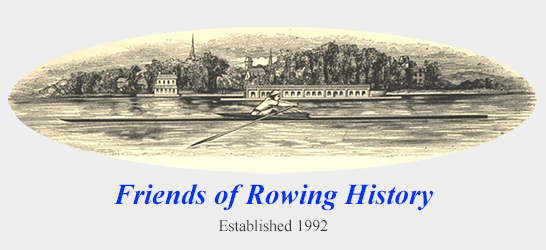A Brief Time Line of Rowing History
Thomas E. Weil
1950-2000
1950 · 40,000 people watched Mervyn Wood of Australia defend the Philadelphia [Gold] Challenge Cup against John B. Kelly, Jr. and England’s Anthony Rowe for the world amateur sculling championship over 2,000 meters on the Schuylkill.
1950’s · Two major developments in Europe revolutionized rowing. While German Karl Adams and his Ratzeburg crews produced victories with harder training and higher ratings, the East European rowing countries, particularly East Germany and the U.S.S.R. developed national sport policies and national teams with international agendas.
1951 · The first FISA sponsored regatta for women was held in conjunction with the men’s European Championships in Macon, France.
1952 · Thomas Price, age 19, from Rutgers, began rowing in January, sat in a pair for the first time in May, and won gold in the U.S. Olympic coxless-pair in Helsinki in July; Navy won the eights for the second time.
1954 · The first European rowing championships for women were held, in Amsterdam, and were swept by the Russians. The Russian squad, together with two Swiss rowers and a Yugoslav, also dominated the medals awards at Henley.
Magdalen College, Oxford experimented with one of the first fiberglass hulls, and the Bedford sliding rigger was championed by British Olympian, author and BRA editor Richard Burnell.
1956 · Yale rowed itself out winning the eights at Lake Wendouree at Ballarat during the Melbourne Olympics, which was boycotted by the Swiss, Dutch and Spanish teams because of the Soviets’ actions in Hungary. The U.S. was also victorious in the coxless and coxed-pairs. The Soviets won the single and the double.
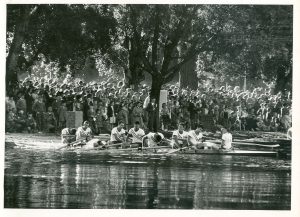
Sports Illustrated – Dec 10, 1956,
Bill Miller Collection
1959 · The tulip blade was popularized at the European Championships in Macon.
Oxford won despite its first “mutiny” led by Yale’s Reed Rubin.
1960 · Oxford introduced spoon oars to the Boat Race.
The Rome Games witnessed the first defeat of a U.S. eight in Olympic finals history, as Navy finished last behind the victorious Germans, who also won the coxed-fours and pairs. The Soviets won the coxless-pair and single, while the U.S. won the coxless-four.
1961 · Cambridge trained for the Boat Race utilizing an unwieldy and primitive device developed in Australia and called an “ergometer.”
The Western Sprints were first held.
1962 · One of the oldest records in sport fell when Yale’s Boyce Budd weighed in at 15 stone 1 pound for a victorious Cambridge crew, breaking the mark for the heaviest Boat Race oarsman, held since 1829 by Oxford’s Rev. Toogood at 14 st. 10 lb.
Stuart Mackenzie, Australian, won his sixth straight Diamonds, a record not since matched until Mahe Drysdale’s 2018 victory.
The first FISA world rowing championships were held, in Lucerne, Switzerland.
The National Women’s Rowing Association (NWRA) was formed by Joanne Wright Iverson (Philadelphia Girls Rowing Club), Ted Nash (Lake Washington Rowing Club) and Ed Lickiss (Lake Merritt Rowing Club).
1963 · British rowing took several important steps forward with the appointment of its first director of training and of its first national coach, and with the integration of the Women’s Amateur Rowing Association into the ARA.
Harry Parker began his career as the head coach at Harvard with an upset victory over Yale, the first of a string of 18 H-Y wins, and the beginning of a career as the most important U.S. college coach of the second half of the century.
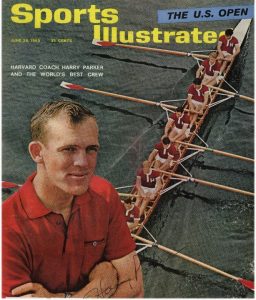
1964 · The spare from the 1914 Harvard crew that won the Grand set a record for frustrated patience as the entire crew returned to row the Henley course after 50 years; there was still no place for the spare in the boat.
On the Toda course in Tokyo, Russian sculler Viacheslav Ivanov won his third consecutive single sculls Olympic gold medal; the Soviets also took gold in the double. The U.S. (Vesper) recaptured the eights title, and (Stanford Crew Assn.) won the coxed-pair.
pic 1964 US Olympic Gold Medal Eight – Vesper B.C. © Archives IOC
1965 · The first Head of the Charles was held in Cambridge/Boston, Massachusetts, and has since grown to be the biggest regatta in the U.S.
1966 · The East German men took five Henley titles, followed by a chaser of three golds at the World Championships at Bled, ending a decade of dominance of the international rowing scene by the Russians.
Two British Marines, Ridgway and Blyth, rekindled interest in trans-oceanic crossings by rowing from Cape Cod to Ireland in three months; another crew attempting the same feat, Johnstone and Hoare, were lost at sea.
The National Rowing Foundation was established to support U.S. rowing.
The first National Women’s Rowing Association (NWRA) National Championship was held in Seattle Washington.
1967 · The first FISA Junior Regatta was held, in Ratzeburg, Germany.
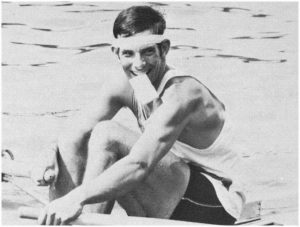
NAAO Rowing Guide,
Bill Miller Collection
Philadelphia Girls Rowing Club sent the first U.S. representative women’s eight (as well as a quad) to a FISA championship.
The IRA was last contested over a 3-mile course with 16 boats racing side-by-side.
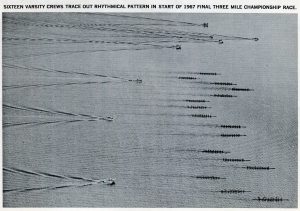
Bill Miller Collection
1968 · The West German eight was victorious at Xochimilco at the Mexico City Olympics; Harvard was the last non-national team eight to represent the U.S. at the Games, the first in which a competing U.S. team did not win a single event. The East Germans won the coxless-pair and four.
1969 · Tom McClean completed the first solo eastward trans-Atlantic crossing rowing from Newfoundland to Ireland, and John Fairfax completed the first solo westward trans-Atlantic crossing rowing from the Canary Islands to Miami.
Arthur Martin launched the Alden Ocean Shell and started a movement toward recreational sculling.
1970 · The introduction of the Gamut ergometer to U.S. circles initiated changes in training and selection processes in most rowing programs.
The East Germans took gold or silver at every event at the World Championships in St. Catherines, which included an exhibition event for lightweight eights.
1972 · Harry Parker conducted the first selection of a U.S. national camp eight and coxed-four. A New Zealand eight beat the U.S. to the finish in the Munich Olympics. The East Germans won the coxed and coxless-pair and four, while the Soviets won the single and the double.
The passage by the Congress of Title IX of the Omnibus Education Act of 1972 changed the face of women’s rowing in the United States.
John Fairfax and Sylvia Cook completed a year’s rowing odyssey from San Francisco to Australia.
German manufacturer Empacher Bootswerft pushed the frontiers of shell construction with the successful utilization of composite materials [Miller].
1973 · The U.S. entered its first national women’s squad in the European rowing championships.
1974 · The initial San Diego Crew Classic was held, establishing an event which provides the first major competition of the spring season for collegiate crews.
The first FISA world championships for women and for lightweight men were held, in Lucerne. The women’s distance was set at 1,000 meters. The U.S. men won the eight and the single (Bill Belden).
Kent School coach Hart Perry was the first foreigner elected a Henley Steward.
1975 · The U.S. women’s eight, coached by Harry Parker, the first selected based on a national camp system, won a silver medal in the World Rowing Championships.
1976 · The Montreal Olympics, held on the Notre Dame course, had the first women’s Olympic rowing, at a 1,000 meter distance, and U.S. women won silver in the single (Joan Lind) and bronze in the eight; the East Germans won both the men’s and women’s eights, as well as the men’s coxless and coxed-pairs, the coxless-four, and the quad, and the women’s single, coxed-four and quad. Bulgaria won the women’s double and coxless-pair, and the U.S. men avoided their first Olympic rowing medal shutout ever with a silver in the coxless-pair.
The Yale women’s crew made national headlines with their Title IX protest strip.
1977 · The Dreissigackers began production of light, durable composite material oars [Miller].
1980 · The U.S. boycotted the Moscow Olympics over the invasion of Afghanistan, while the East German men and women again took both eights titles, as well as the men’s coxless and coxed-pairs and fours, and the double and the quad, and the women’s coxless-pair, coxed-four and quad.
1980’s · Vespoli boats became the standard of choice for most U.S. rowing programs.
1981 · Steering Oxford to victory, Sue Brown became the first woman to take part in the Oxford-Cambridge Boat Race.
Henley Royal Regatta initiated its cautious experimentation with women’s racing.
The Concept II erg was put on the market; the institution of the first CRASH-B Sprints at Harvard’s Newell Boathouse on January 20, 1982 gave meaning to winter training, and additional selection criteria to coaches [Miller].
The NAAO changed its name to the United States Rowing Association and major constitutional changes were ratified.
1983 · The appointment of Poland’s Kris Korzeniowski by the USRA as the first National Technical Advisor and full-time national coach introduced European techniques to U.S. rowing.
1984 · As the Eastern bloc boycotted the Los Angeles Games, Finnish sculler Pertti Karppinen won his third consecutive Olympic single sculls title, Steve Redgrave, rowing in the coxed four, won the first of his five gold medals in consecutive Olympics, and Canada won the men’s eight. The U.S. won the women’s eight and the men’s double at Lake Casitas. Romania won every other women’s gold. UCSB’s David Farmer organized the first major U.S. exhibition of rowing art and memorabilia.
1985 · The first FISA women’s lightweight world championships were held (in conjunction with the men’s championships at Hazewinkel), and the FISA and Olympic course distance for women was increased to 2,000 meters.
The USRA moved from Philadelphia’s Boathouse Row to Indianapolis.
1986 · The NWRA dissolved in recognition of the assumption by the USRA of responsibility as the national governing body for women’s rowing.
1987 · Oxford’s second “mutiny” led to books, a movie and a victory without U.S. rowers.
1988 · The West German men and East German women were the victorious eights on the Han River at the Seoul Olympics, and the DDR men also won the single and the coxed and coxless-fours, and the women also won the single, the double, the coxed-four and the quad. The Italian men won the coxless-four and the quad, and Steve Redgrave, rowing with Andy Holmes in the straight pair, won the second of his five gold medals in consecutive Olympics.
The first Women’s Henley Regatta was held.
1990 · The World Cup was established by FISA for men’s and women’s singles.
1991 · “hatchet” oar blades were first introduced by the Dreissigackers [Miller].
1992 · The Canadian men’s eight and the women’s coxless-pair, four and eight were triumphant and an amazing comeback by severely injured Silken Laumann, Canada, for the bronze medal on Lake Banyoles at the Barcelona Olympics, while the Germans took the men’s single and quad and women’s double and quad, and the Australians won the men’s double and coxless-four. Steve Redgrave, rowing with Matthew Pinsent in the straight pair, won the third of his five gold medals in consecutive Olympics.
1993 · Thomas Mendenhall’s history of the Harvard-Yale boat race represented the first major scholarly work published on U.S. rowing.
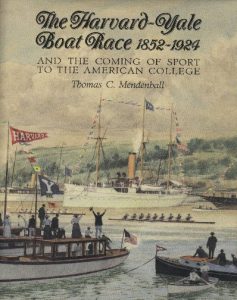
by Thomas C Mendenhall,
Bill Miller Collection
1996 · The Atlanta Olympics had the first men’s and women’s Olympic lightweight rowing; Steve Redgrave, again paired with Matthew Pinsent, won gold in his fourth consecutive Olympics with a victory in the coxless-pair, the only gold won by Britain in the entire Games. The Netherlands men’s eight and the Romanian women’s eight, as well as their lightweight double, brought home golden memories of Lake Lanier. The Swiss men were victorious in the single and the lightweight double.
Yale’s Helen Cooper organized the first exhibition devoted to Thomas Eakins’ rowing images, at the National Gallery, Yale and the Cleveland Art Museum.
1997 · The first woman was elected a Henley Steward, and women were admitted as members at Leander Club.
The U.S. men’s eight, stroked by Chris Ahrens and coached by Mike Teti, won their first of three consecutive World Championship gold medals.
Women’s rowing became a National Collegiate Athletic Association sport.
1998 · The U.S. men’s eight, stroked by Chris Ahrens and coached by Mike Teti, won their second consecutive World Championship gold medal.
The quest for a rowing museum was realized when the River and Rowing Museum at Henley was formally opened by Queen Elizabeth (November 6).

1999 · The U.S. men’s eight, stroked by Chris Ahrens and coached Mike Teti, won their third consecutive World Championship gold medal.
2000 · The amazing Steve Redgrave commanded huge media coverage rowing in the British coxless-four and winning his fifth Olympic gold medal in five consecutive Olympics, an accomplishment never before achieved in any endurance sport.
- Tom Weil rowed at Andover and Yale, and has collected rowing books, prints and memorabilia and written and lectured on rowing art and history for over thirty years. He is a life member of the United States Rowing Association, the North American Society for Sport History and the Leander Club. Along with the Friends of Rowing History, Tom has been active with the River Rowing Museum in Henley where he is a trustee.
